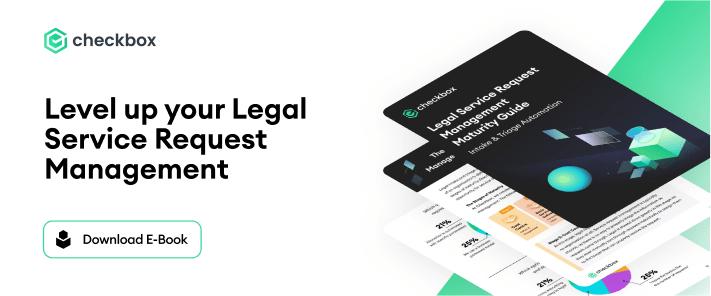
Sign up to our newsletter
Get insightful automation articles, view upcoming webinars and stay up-to-date with Checkbox
Reading time:
[reading time]

In the vast landscape of the legal technology market, the sheer volume of options available for legal ops professionals can often lead to confusion and make it difficult to make the right purchase decision for their department.
However, navigating legal technology can be simplified as the ideal technology solution for your legal department is greatly correlated with the maturity level of the function. It is important to note that the ‘hottest trends’ come and go and while there may be alternative technologies that appear appealing, they may not effectively address the current needs of your legal function.
An established leader in the legal operations space, Jeffrey Franke, CEO of LegalOps.com, previously the founder of CLOC (Corporate Legal Operations Consortium), Chief of Staff & Assistant General Counsel and Legal Operations at Yahoo recently shared his key insights on the Legal Operations Maturity Model and when it would be best for teams to bring in workflow automation. This was as part of a live session with Evan Wong, CEO & Co-Founder of Checkbox and host of the ‘Go with the Workflow’ web series, where the podcast episode and recording can be accessed here.
From dissecting the role of legal operations to the impact of workflow automation and how it is fundamental to partnering with the business, Jeffrey explores those avenues through the Legal Operations Maturity Model.
The Goal of the Legal Ops
The role of legal operations covers much more than just driving efficiency and implementing technology. Jeffrey explains that the role of general counsels (GCs) and legal operations should very much be aligned and focused on being a strategic asset to the company and driving overall business success.
“The legal operations role is about taking and enabling the strategic plan that the GC has. I would argue that the ultimate paradigm in this is for the legal department to serve as a driver of competitive advantage for the company,” says Jeffrey. “Delivering that competitive advantage must come from the legal ops function enabling the GCs to implement their strategic goals.”
The Legal Ops Maturity Model & Workflow Automation
At the foundational level together with basic e-signature and e-billing, workflow sits at the base of the legal ops model, allowing automation of common document creation and other elements to move teams to the top of the maturity pyramid, says Jeffrey. “Workflow really is foundational; I would probably put it at the foundational level one.”

In fact, workflow automation is so foundational to legal ops that for legal departments, or companies, that are more than 30 months (about 2 and a half years) old, it should already have workflow in place. "At 30 months, there are enough policies and processes going on within the company, that it’s an ideal time, a foundational time, to implement workflow,” says Jeffrey.
When starting from scratch, workflow should be the first tool implemented within a company’s infrastructure and internal processes. Workflow automation will make the biggest difference in a team’s operation from the very start. While e-signature and e-billing are foundational tools, workflow automation is not considered nearly enough as a fundamental tool that needs to be brought into the business.
One area that Jeffrey points out where automation can play a critical role is in compliance, specifically privacy and data security. “If you can leverage technology to really lock down the security and privacy processes and ultimate infrastructure to secure what you have, that can put you in a position where people are more inclined to buy from you than they are your competitors,” says Jeffrey. "If you are so far ahead of the game that your customers come to you for [privacy and security], that’s a competitive advantage, and it’s almost fully automated.”
A major pain point today for legal teams is ensuring security and compliance across an organization, keeping data safe for customers. GCs need the time to focus on ensuring that customers/clients’ data are being protected and maintaining the integrity of an organization. Ultimately, bringing legal practices to a commoditized level is what brings a competitive advantage to a company, and this can be achieved through workflow automation.
“Workflow tools also tie into self-help and self-service tools that can be a pathway to some of that work, and help [legal ops] get to the ultimate top of the pyramid,” adds Evan.
Bringing in Workflow to Build a Legal Front Door
A strong demand right now for legal teams is the use and creation of a legal front door, where business users can have access to legal knowledge and advice automatically, without the need to engage a lawyer. Legal departments are looking to create a front door for their function but do not recognize that workflow automation is what needs to be brought in to implement that. “Workflow allows you to create a front door that is awesome for the purposes of allowing your clients to know where to go,” says Jeffrey.
The front door also helps collect data and allows full visibility into what lawyers in the department are working on. “If you do not have the data to figure out, for example, how many NDAs you are doing, there is a challenge in trying to figure out from a strategic planning standpoint, to justify those resources. Conversely, if you have this data, you can go to executive management and show how you are supporting different functions to secure more budget,” says Jeffrey.
Securing additional resources is one of the biggest challenges facing legal teams, but it is also one of the biggest opportunities for legal ops to be a provider of value. Workflow, however, gives legal teams the unique way of collecting data through powerful dashboarding solutions and other tools to help show that data value.

Bringing in Workflow vs. CLM (Contract Lifecycle Management)
During the webinar, Evan mentioned that CLM was not included in Jeffrey’s foundational level in the maturity model, prompting the age-old question: Does workflow come before CLM, and if so, why?
“CLM is one very specific type of workflow within a legal department,” says Jeffrey. “Workflow tools like Checkbox and others in the industry, however, are less specific. They are open to any type of workflow depending upon the platform like a Checkbox. You can and many cases create your own type of CLM solution.”
Instead of bringing in a CLM solution, much of the time, legal can cover the most important parts of CLM with an workflow automation platform, which typically has easier implementation and less complexity in its usage. “Workflow is a nice learning basis for CLM because you start to learn how to map out a workflow and then you start to understand different elements that can be part of a workflow document,” says Jeffrey.
Bringing in CLM into the team before workflow can also be consequential to the team. “I think people may bring in CLM when it’s still too early,” said Jeffrey. “At that point, lawyers are almost using CLM as a workflow tool, but without the flexibility or cost efficiency of workflow. CLMs can get expensive quickly based on their pricing model, just to do what is a workflow within the CLM system.” As a result, bringing in workflow later than CLM can cause more confusion for lawyers and create unnecessary costs, emphasizing the need to bring in workflow before CLM in the maturity model. While workflow resides in the foundational level of the pyramid, CLM lives in the secondary level of the pyramid under technology process support and management.
Since CLM can be overly complex to work with, workflow offers a simpler starting point for change management with lawyers on the legal team. “Workflow allows you to capture a lot of the pieces to do what you want to do,” says Jeffrey. “It’s a nice starting point change management with lawyers on your team.”
Workflow: It’s Not Just a Legal Thing
Workflow can start in the legal department, but that does not mean that it is only limited to legal. Although it can start within legal, it can easily leak into other departments, bringing that competitive advantage to the rest of the departments within the company.
“That's the other powerful thing about workflow, is that you can take a product like Checkbox, implement it within legal and other business units within the company, and they can see how powerful it really is,” says Jeffrey. “Since a lot of the time, legal has developed the expertise to build those workflows, they can start to provide that value to other departments and maybe even get to that competitive advantage piece yet again.”
Next Steps
Access the full webinar recording or watch the 1-min recap video below to hear more about when it’s time to bring workflow automation into your legal department.
Is your team ready for workflow? Request a demo today, and one of our legal technology consultants can walk you through on how to get started with Checkbox and hear how other leading teams from Telstra, Woolworths, Coca-Cola Europacific Partners and more achieved success through workflow automation.
Frequently Asked Questions

Checkbox's team comprises of passionate and creative individuals who prioritize quality work. With a strong focus on learning, we drive impactful innovations in the field of no-code.
Book a Personalized Demo
Discover how workflow automation can benefit your team and organization
.png)





